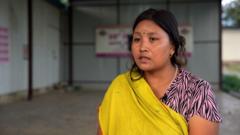Will Families in Violence-Hit Indian State Meet the Resettlement Deadline?

Published: 2025-10-31 01:00:22 | Category: world
Thousands of displaced individuals from the ethnic clashes in India's north-eastern state of Manipur are facing an uncertain future as the government plans to shut down temporary relief camps by December 2023. The violence that erupted in May 2023 between the Meitei and Kuki communities led to significant loss of life and displacement, leaving many without stability or hope for a return to their homes.
Last updated: 21 October 2023 (BST)
What’s happening now
As the deadline for the closure of relief camps looms, tensions remain high in Manipur. The government’s announcement to relocate the displaced population has sparked fears among residents about their future. Many survivors of the violence are apprehensive about moving into new housing units without clear information on their safety or proximity to their original homes. The situation is compounded by the ongoing division between the Meitei and Kuki communities, which continues to be monitored by security forces.
Key takeaways
- Over 60,000 people remain displaced following ethnic violence in Manipur.
- The government plans to close temporary relief camps by December 2023.
- Uncertainty surrounds the location of new housing units for the displaced.
- Many residents fear returning to their original homes due to safety concerns.
- Displacement has led to declining mental health and economic instability among the affected population.
Timeline: how we got here
The situation in Manipur has evolved significantly over the past two years. Key events include:
- May 2023: Ethnic violence erupts between the Meitei and Kuki communities, resulting in over 260 deaths and mass displacement.
- June 2023: Temporary relief camps are established for the displaced population, housing approximately 60,000 individuals.
- July 2023: Chief Secretary Prashant Singh announces plans to close relief camps by December 2023.
- September 2023: Prime Minister Narendra Modi promises the construction of 7,000 new homes for the displaced but provides no specifics.
What’s new vs what’s known
New today/this week
Recent discussions have focused on the government's commitment to resettle displaced individuals, yet critical details about the location and safety of new housing remain vague. This uncertainty has amplified the anxiety among those affected.
What was already established
Two years after the violence, many displaced individuals continue to live in temporary shelters with little support or clarity regarding their future. The government's previous promises of rehabilitation have not materialised, leaving residents in a state of limbo.
Impact for the UK
Consumers and households
While the situation in Manipur may seem distant, it highlights broader themes of ethnic conflict and displacement that resonate globally, including in the UK. The challenges of integrating displaced populations can lead to community tensions and economic strain, relevant for policymakers and social services.
Businesses and jobs
The ongoing instability in Manipur has implications for local businesses, particularly those in industries reliant on community cohesion and stability. The lack of a steady workforce and the closure of businesses due to violence can be mirrored in other regions facing similar challenges. This could serve as a case study for UK businesses dealing with community relations.
Policy and regulation
For UK policymakers, the situation in Manipur may prompt discussions around refugee policies and the support systems necessary for displaced populations. Understanding the complexities of ethnic tensions and the need for effective integration strategies could inform future policies.
Numbers that matter
- 260: The number of confirmed deaths due to the violence in Manipur.
- 60,000: The estimated number of people currently displaced and residing in temporary relief camps.
- 7,000: The number of new homes promised by the Prime Minister for resettlement.
- 290 to 260: The reduction in the number of relief camps as reported by government officials.
- 300,000 rupees: The estimated cost of medical treatment for an injured child, highlighting the financial struggles faced by displaced families.
Definitions and jargon buster
- Meitei: The majority ethnic group in Manipur, primarily Hindu.
- Kuki: An indigenous ethnic group in Manipur, predominantly Christian.
- Relief camps: Temporary shelters set up to provide housing and support for displaced individuals.
- Resettlement: The process of relocating displaced individuals to new homes or areas after a conflict or disaster.
How to think about the next steps
Near term (0–4 weeks)
In the short term, residents are urged to stay informed about government plans for resettlement. Engaging with local leaders and advocacy groups may provide additional support and clarity regarding their options.
Medium term (1–6 months)
As the December deadline approaches, community discussions around safety and integration will be crucial. Monitoring government actions and holding officials accountable can help ensure that the needs of displaced individuals are met.
Signals to watch
- Official announcements regarding the exact location of new housing units.
- Reports on the mental health and economic conditions of those living in relief camps.
- Community responses to government resettlement plans and any emerging tensions.
Practical guidance
Do
- Engage with local community leaders to understand your rights and options.
- Document any government promises regarding relief and resettlement for future reference.
- Seek mental health support if you or someone you know is struggling with the impact of displacement.
Don’t
- Ignore the information provided by government officials; stay updated on changes.
- Neglect personal safety when considering relocation options.
- Assume that the situation will resolve itself without community action or advocacy.
Checklist
- Verify your current housing situation and understand your rights.
- Keep a record of all communications with government officials.
- Identify available community resources for support and assistance.
- Engage in community discussions about safety and resettlement plans.
- Monitor updates on mental health resources available in relief camps.
Risks, caveats, and uncertainties
The situation in Manipur remains fluid, with ongoing tensions between the Meitei and Kuki communities. The government's plans for resettlement are still unclear, and promises made may not be fulfilled. Additionally, the psychological impact of prolonged displacement is significant, and without adequate support, mental health issues may escalate.
Bottom line
The future for displaced individuals in Manipur is fraught with uncertainty as the government pushes to close relief camps by December. Without clear information on resettlement and ongoing community divisions, many face a precarious existence. The situation calls for urgent attention and action to ensure safety and stability for all affected parties.
FAQs
What are the main causes of the violence in Manipur?
The violence in Manipur stemmed from tensions between the Meitei and Kuki communities over demands for tribal status and access to government benefits, leading to widespread clashes.
How many people are currently displaced in Manipur?
Approximately 60,000 individuals are currently displaced and living in temporary relief camps due to the ethnic violence in Manipur.
What is the government’s plan for resettlement?
The government plans to close all relief camps by December 2023 and has announced the construction of new homes for the displaced, though details about the location and safety of these homes remain unclear.



